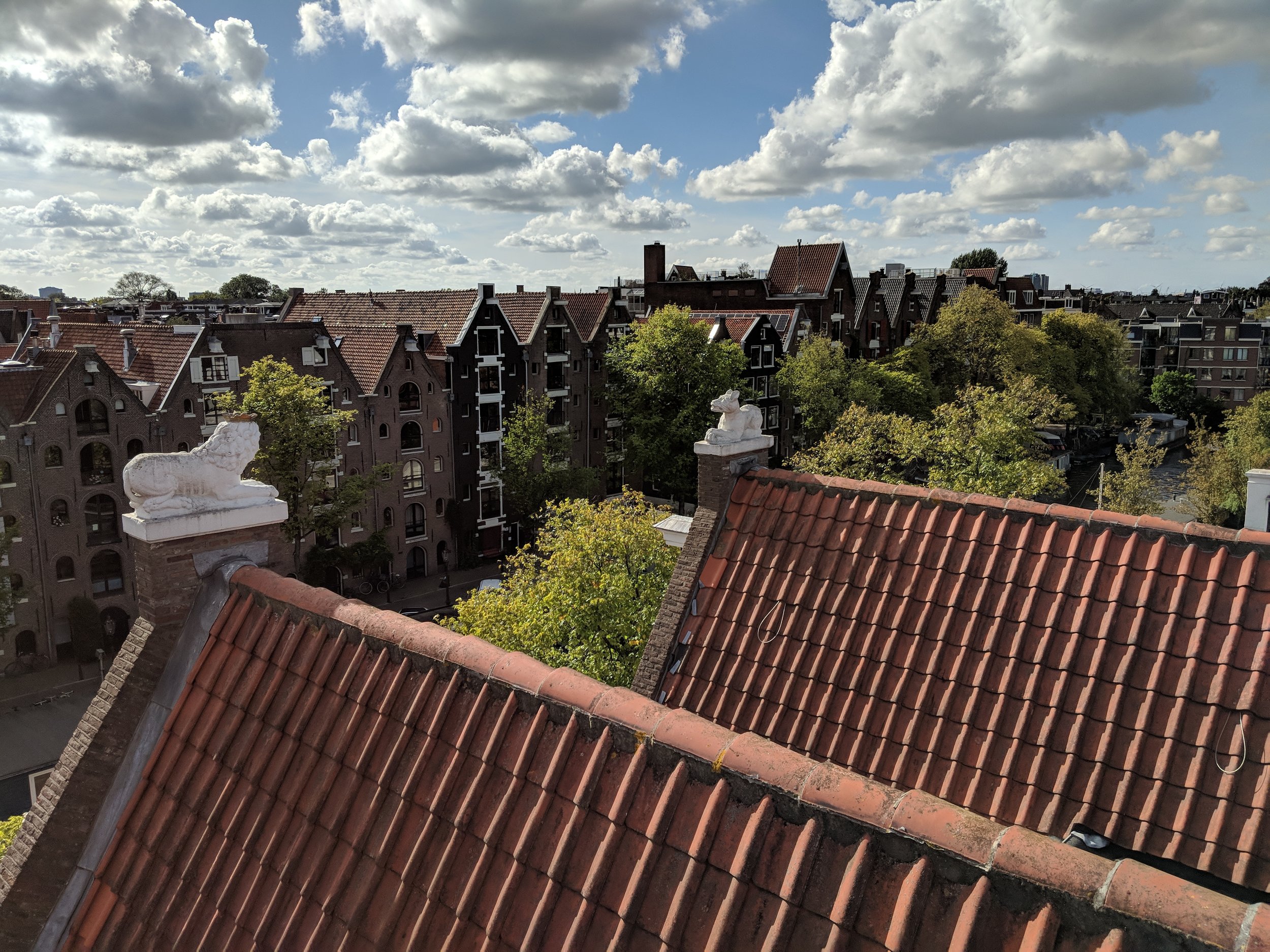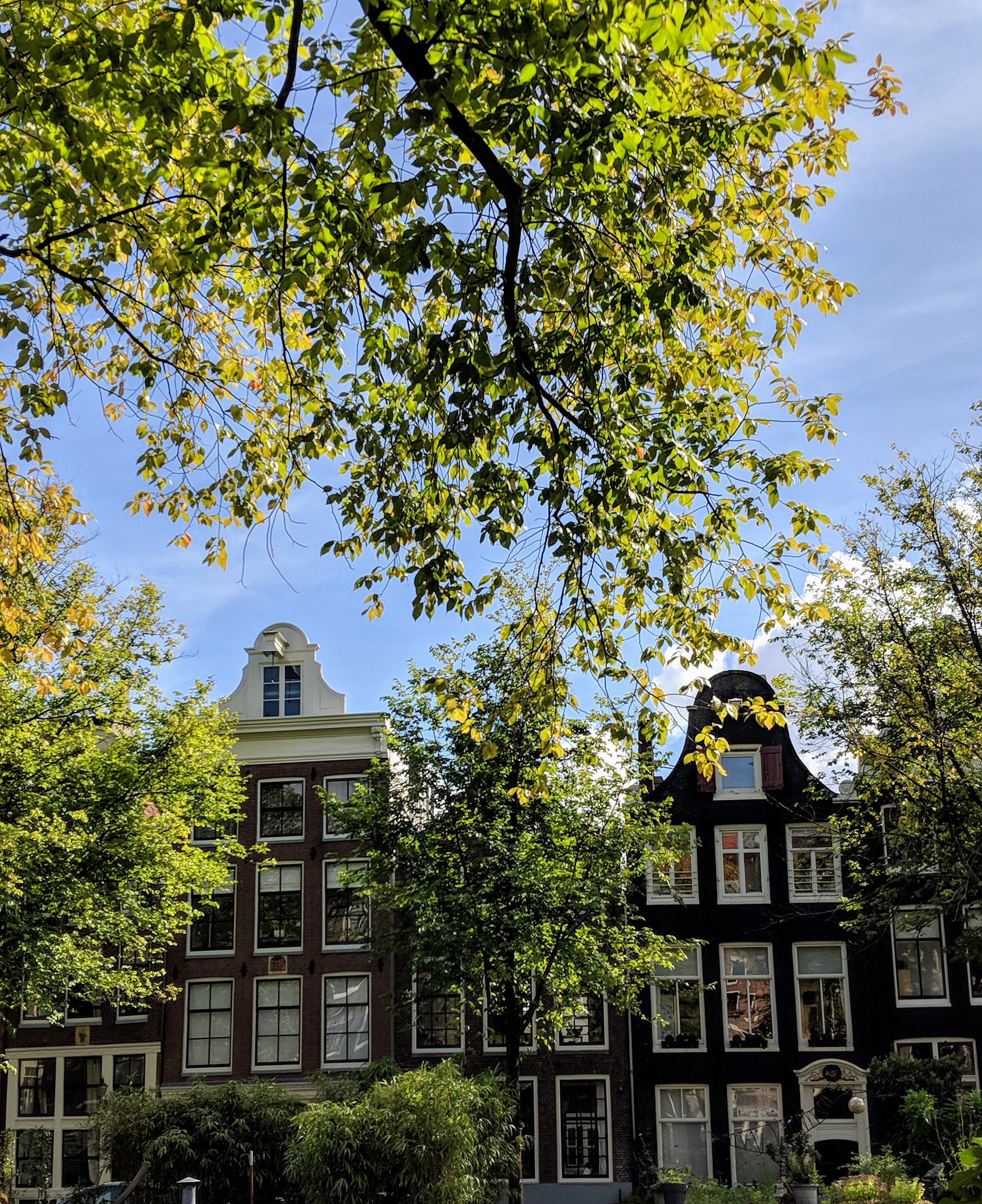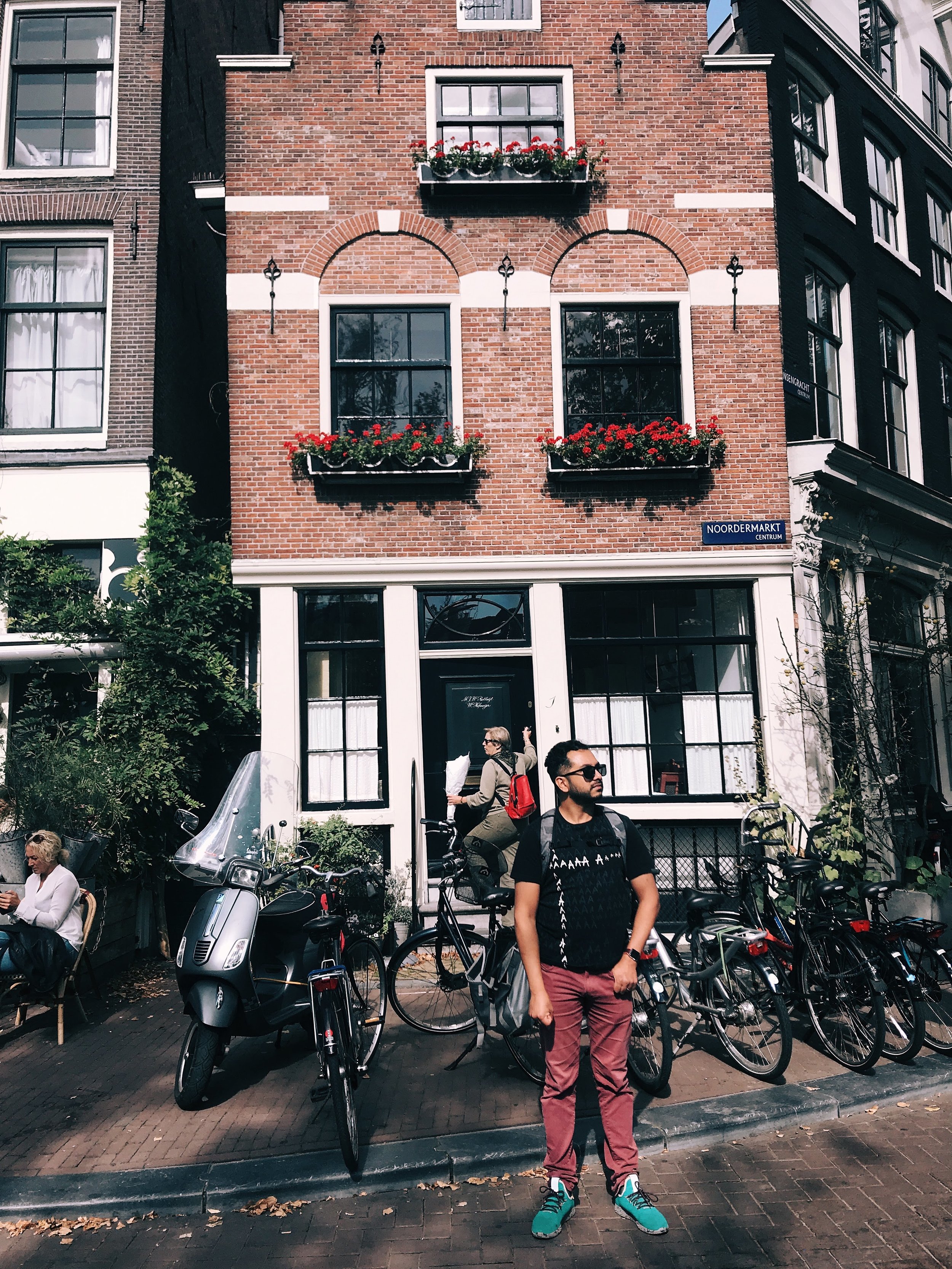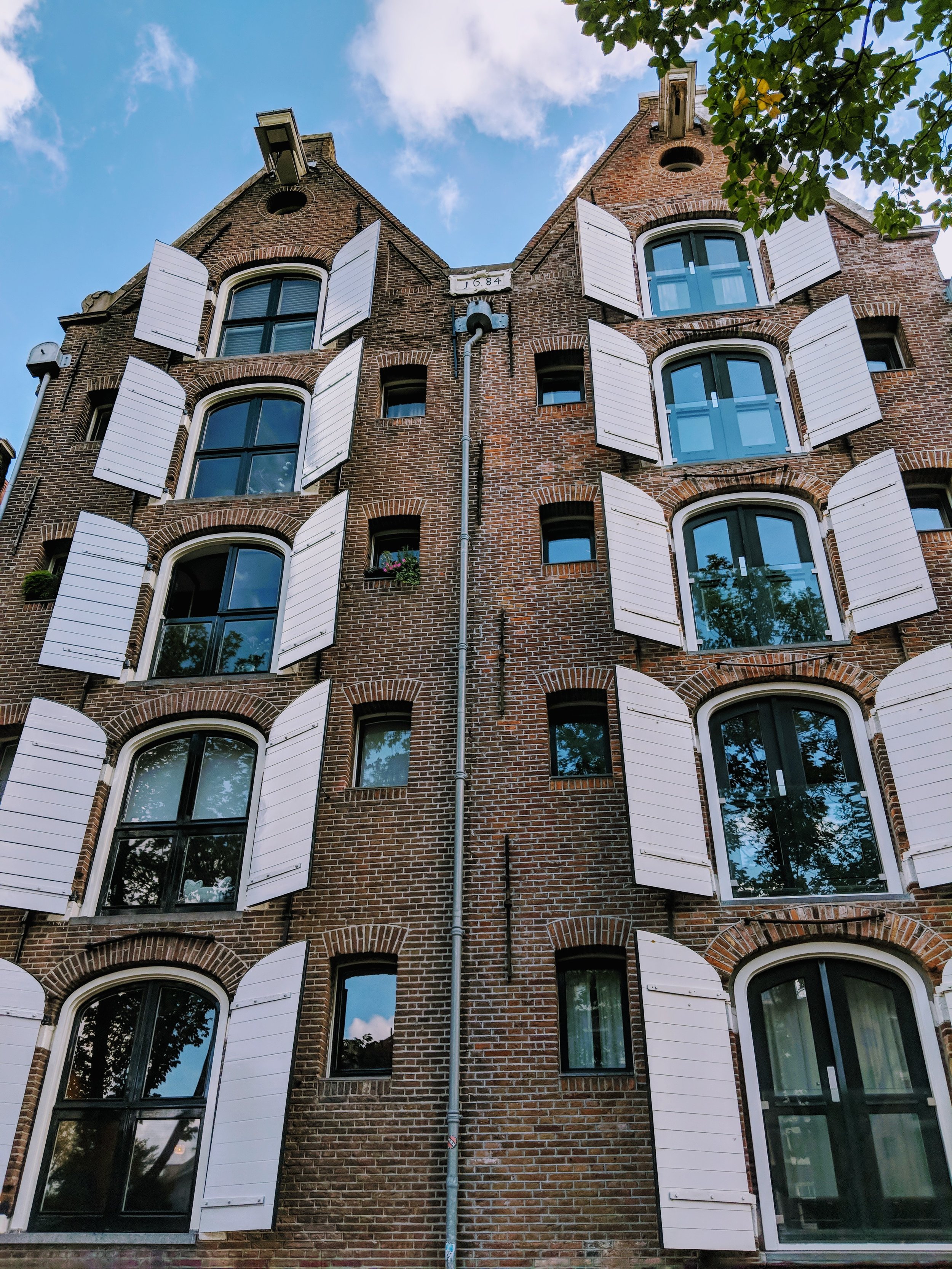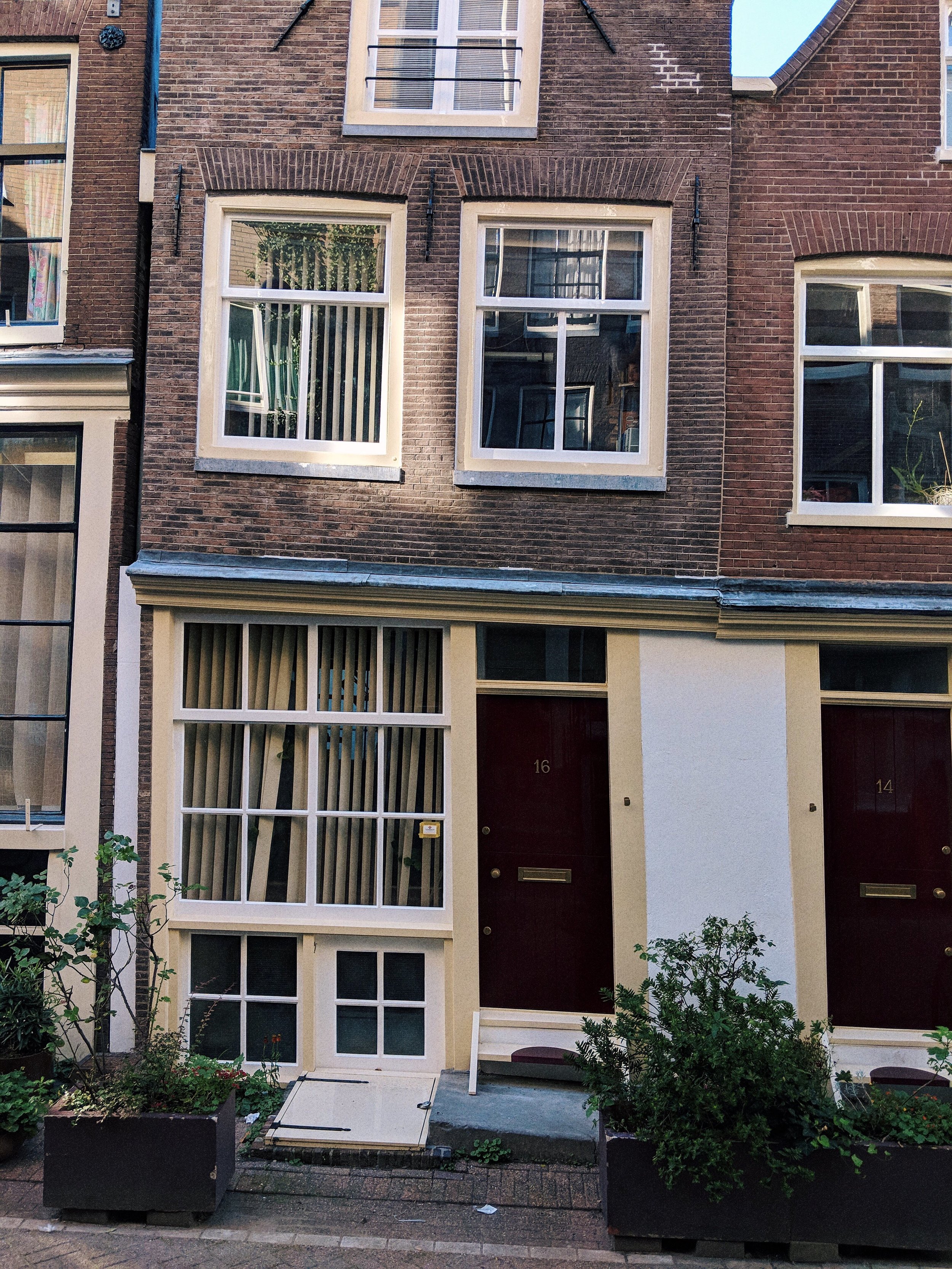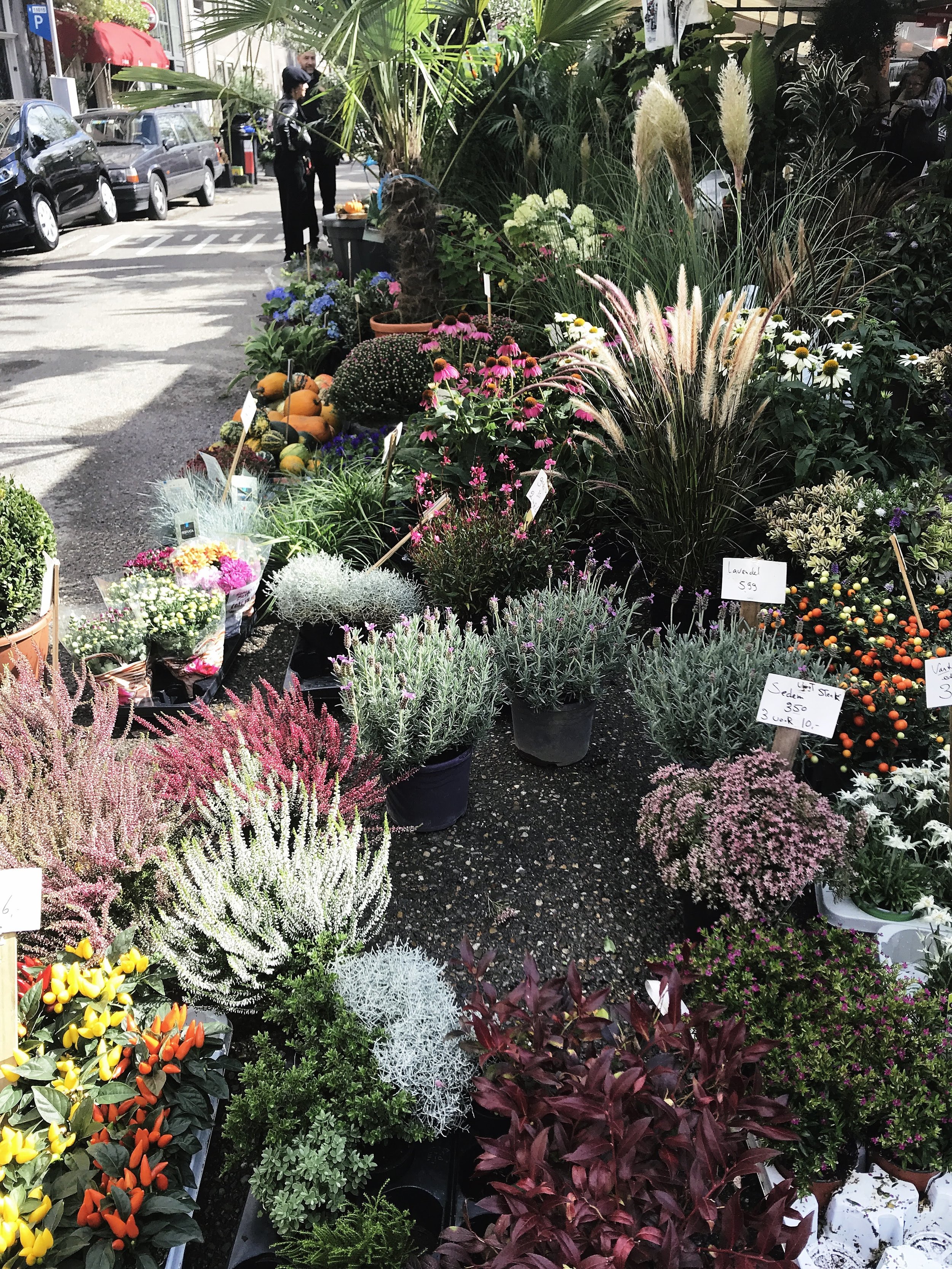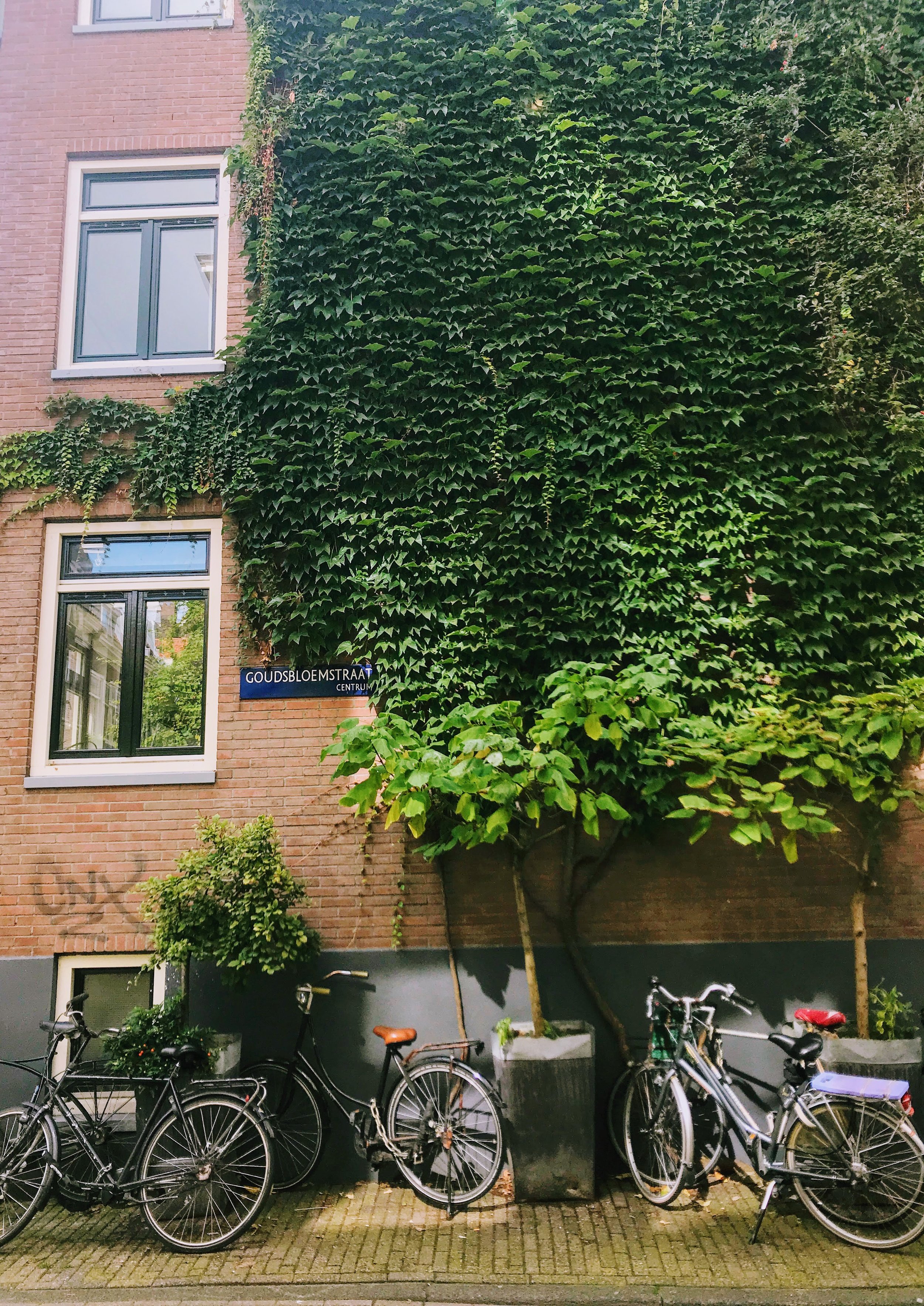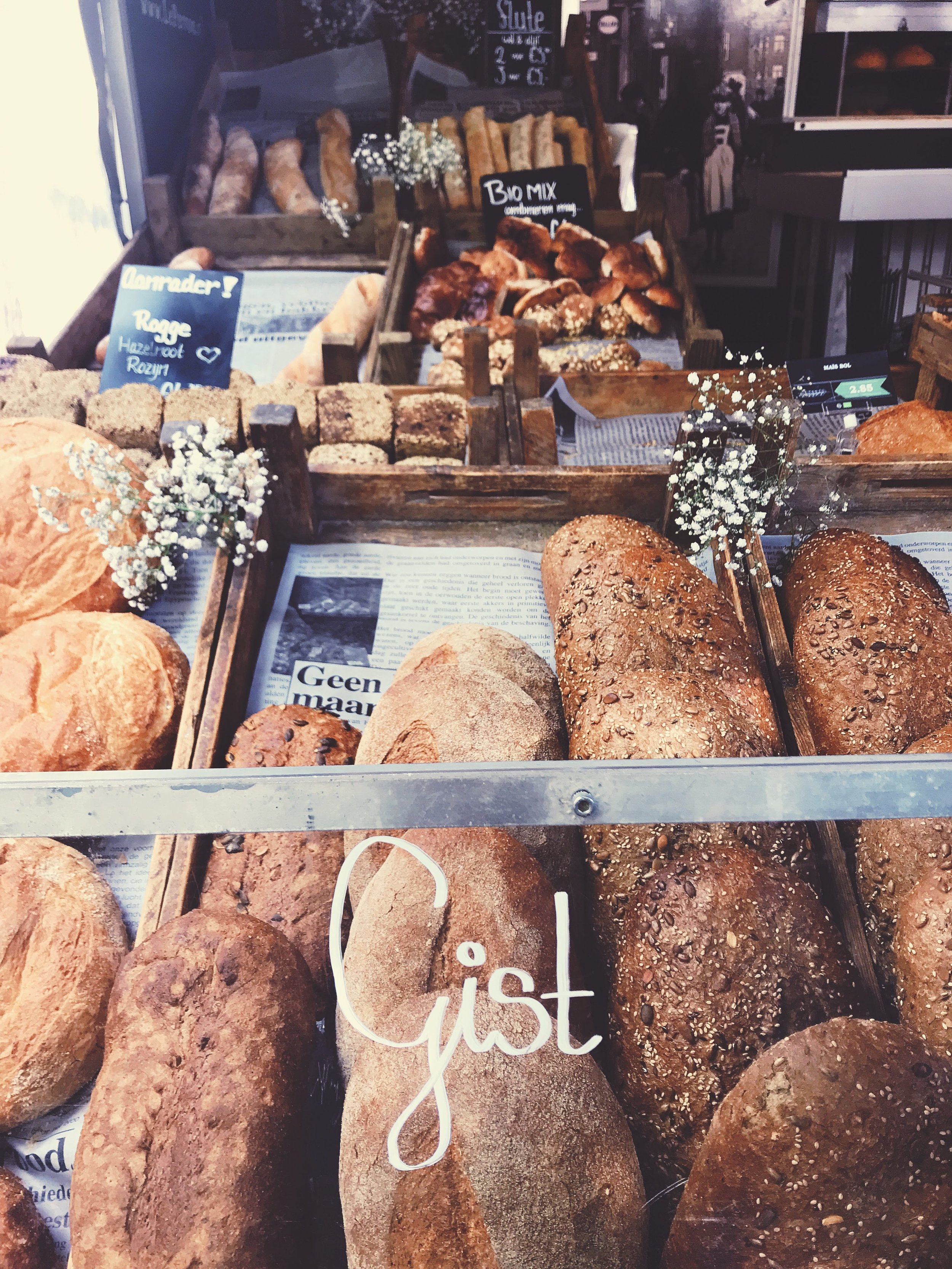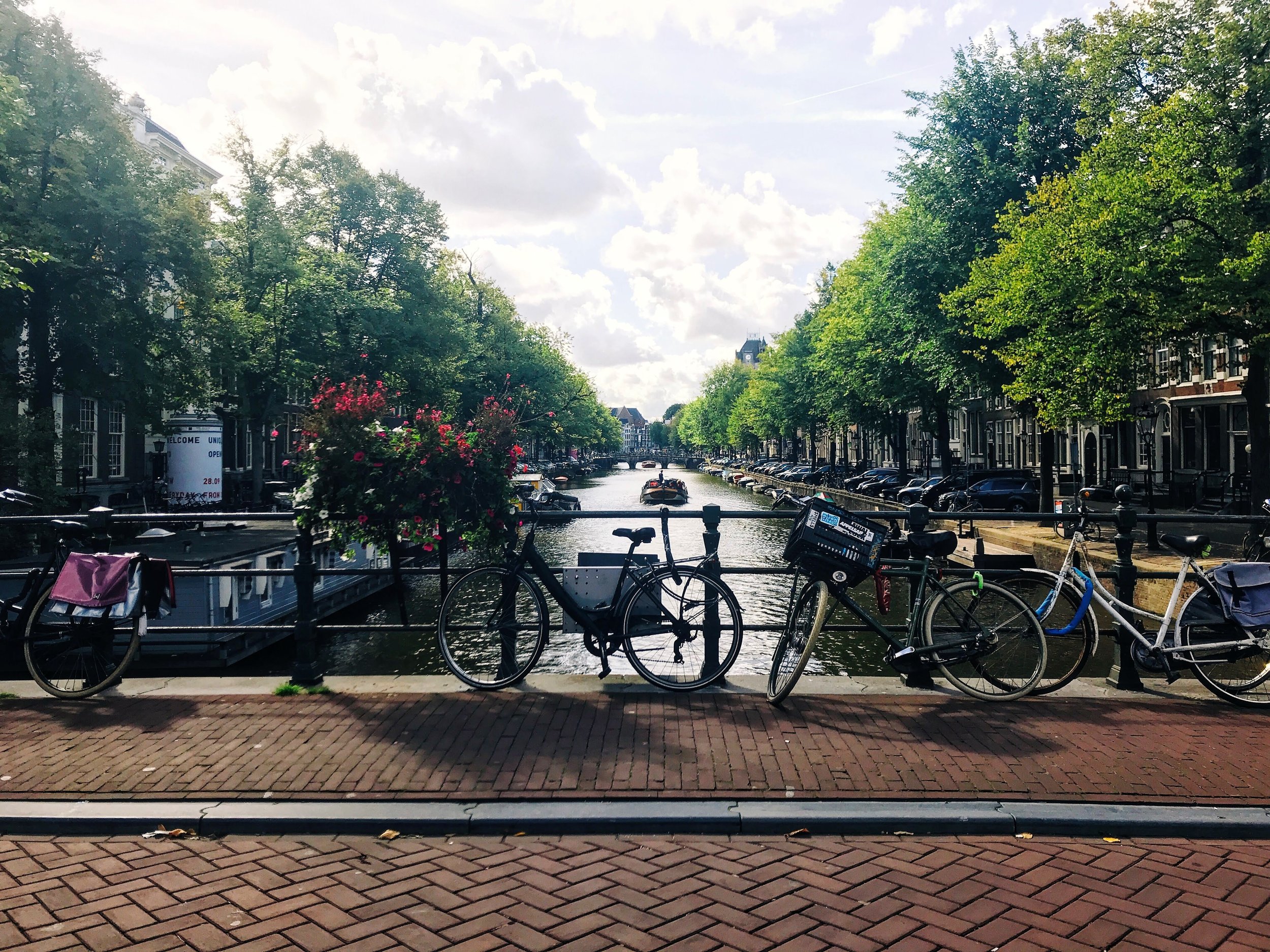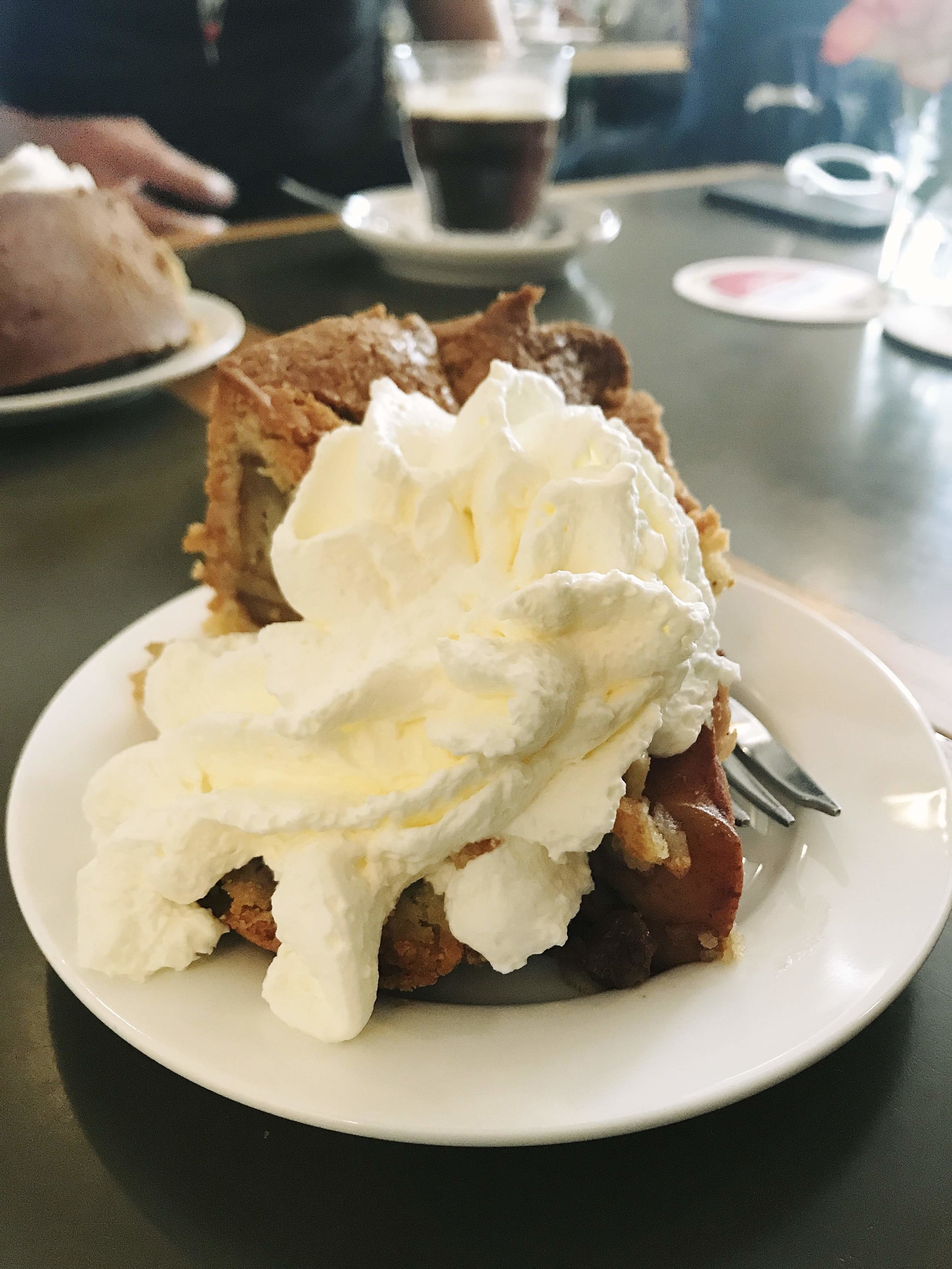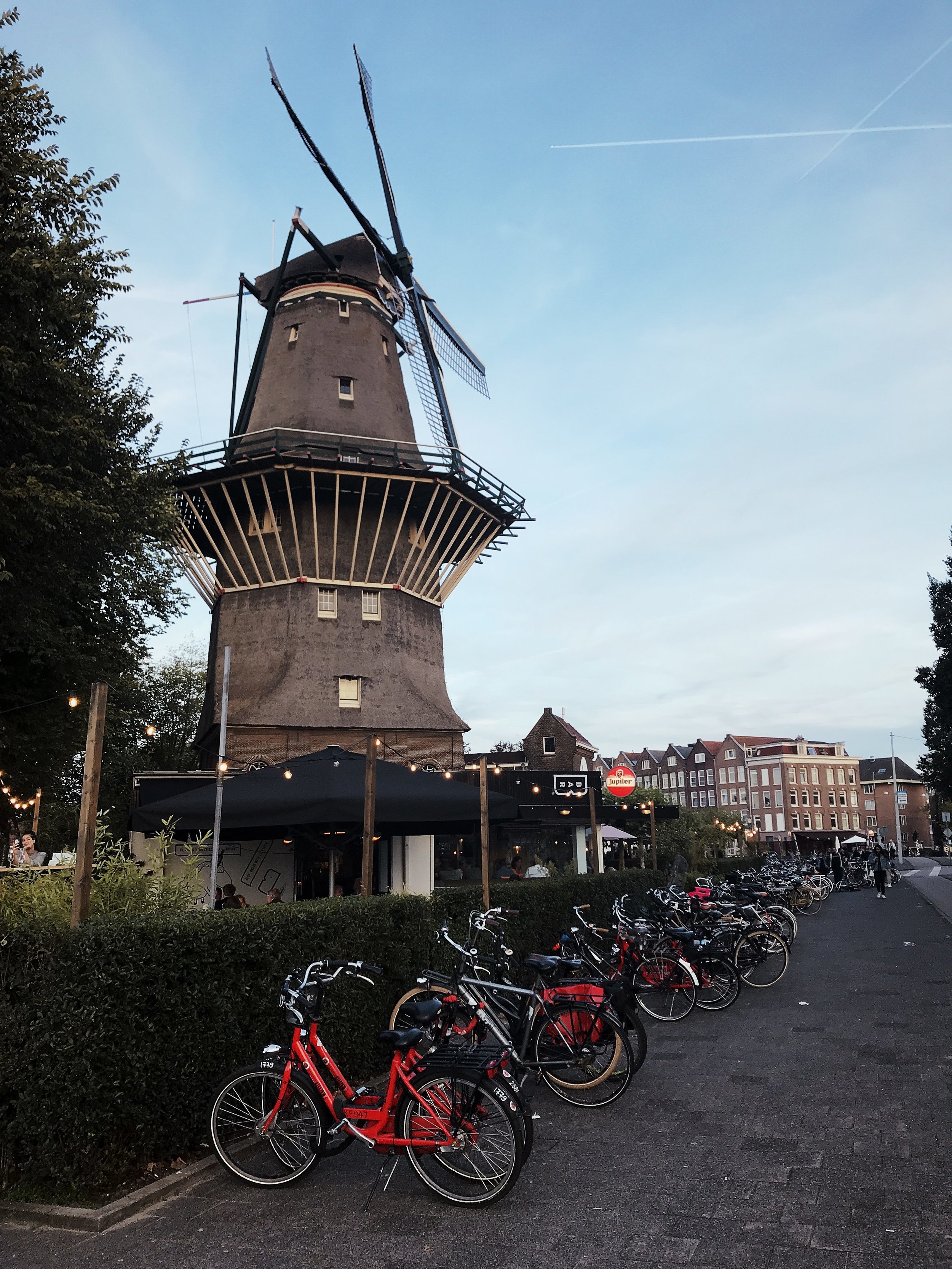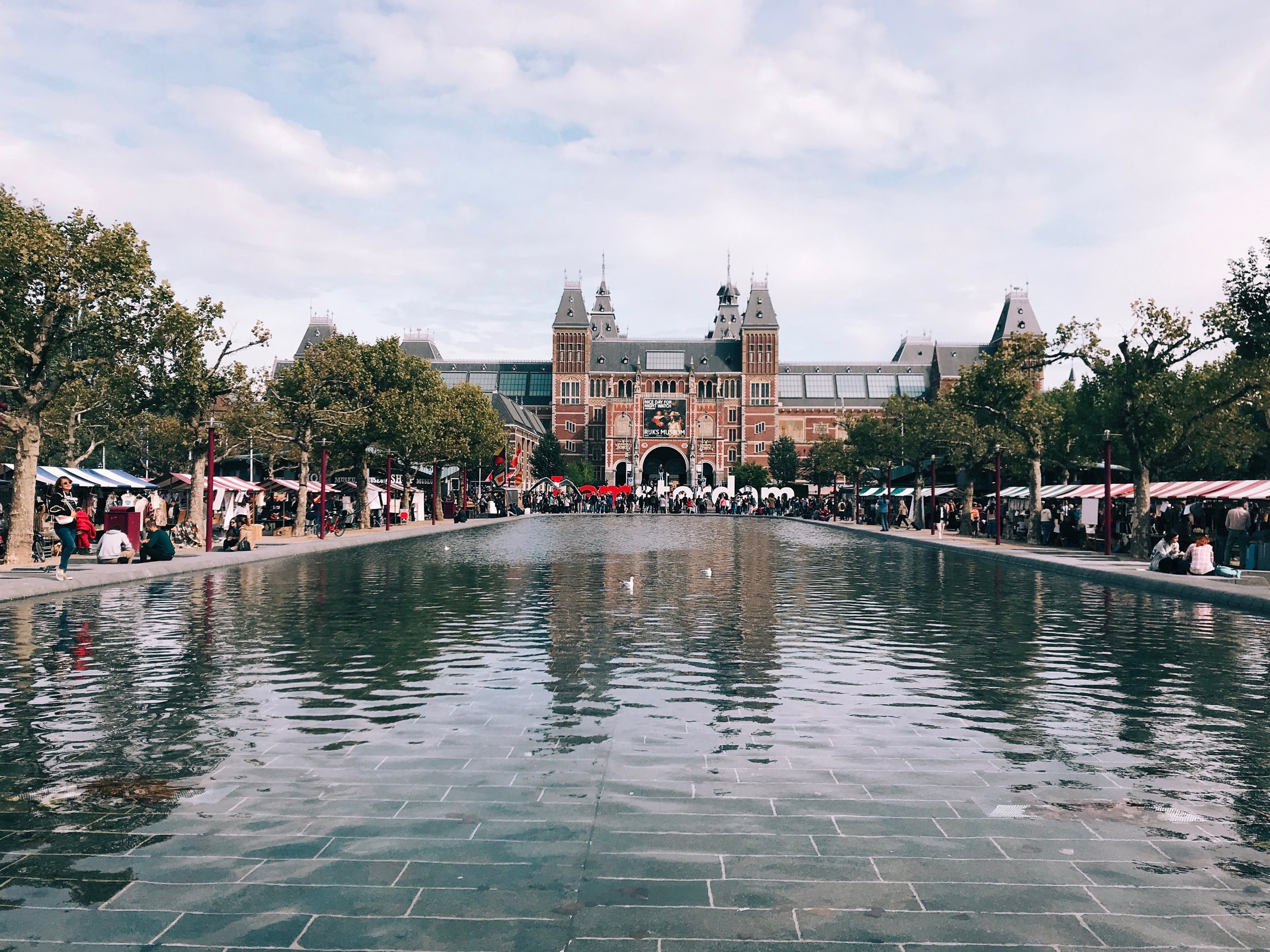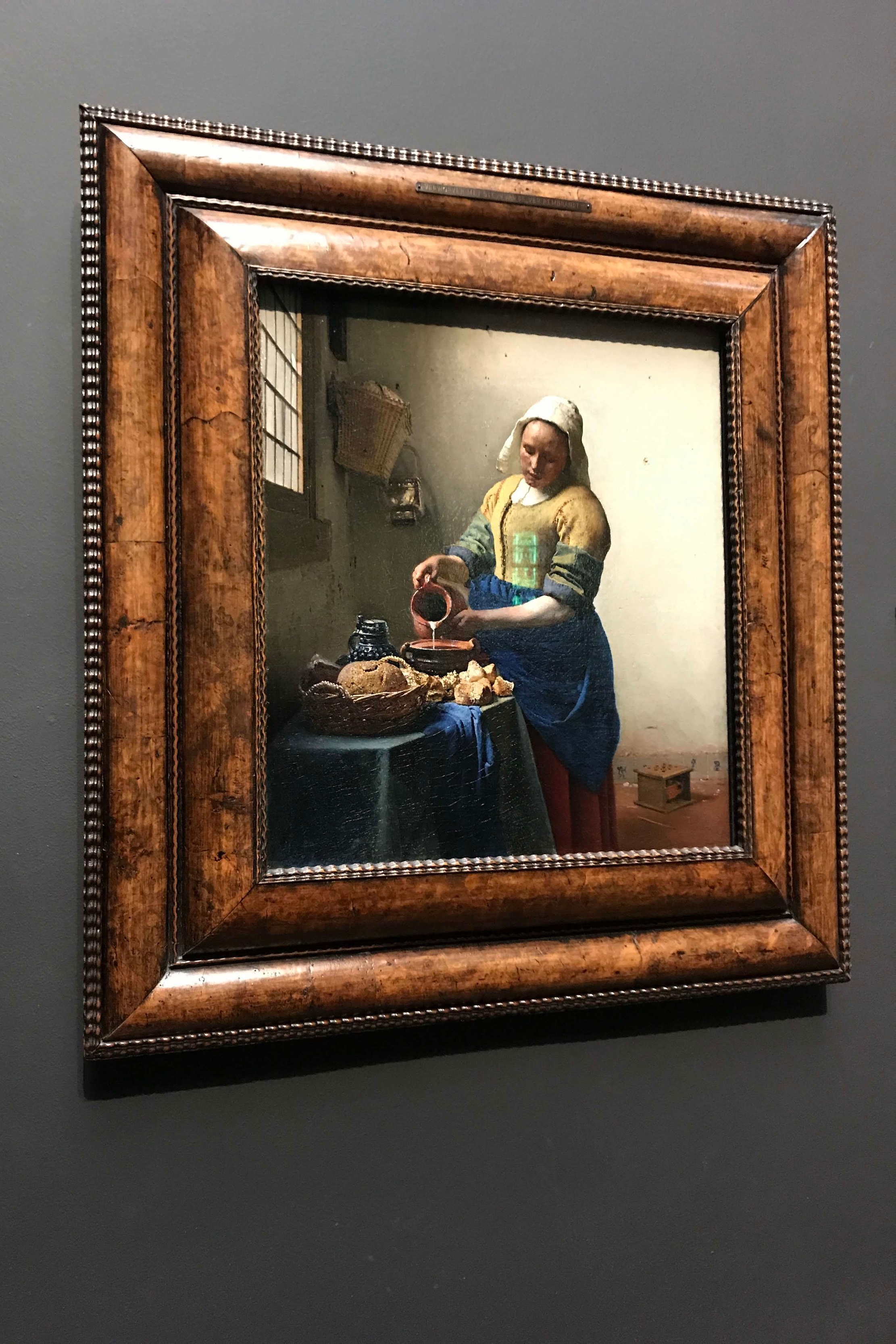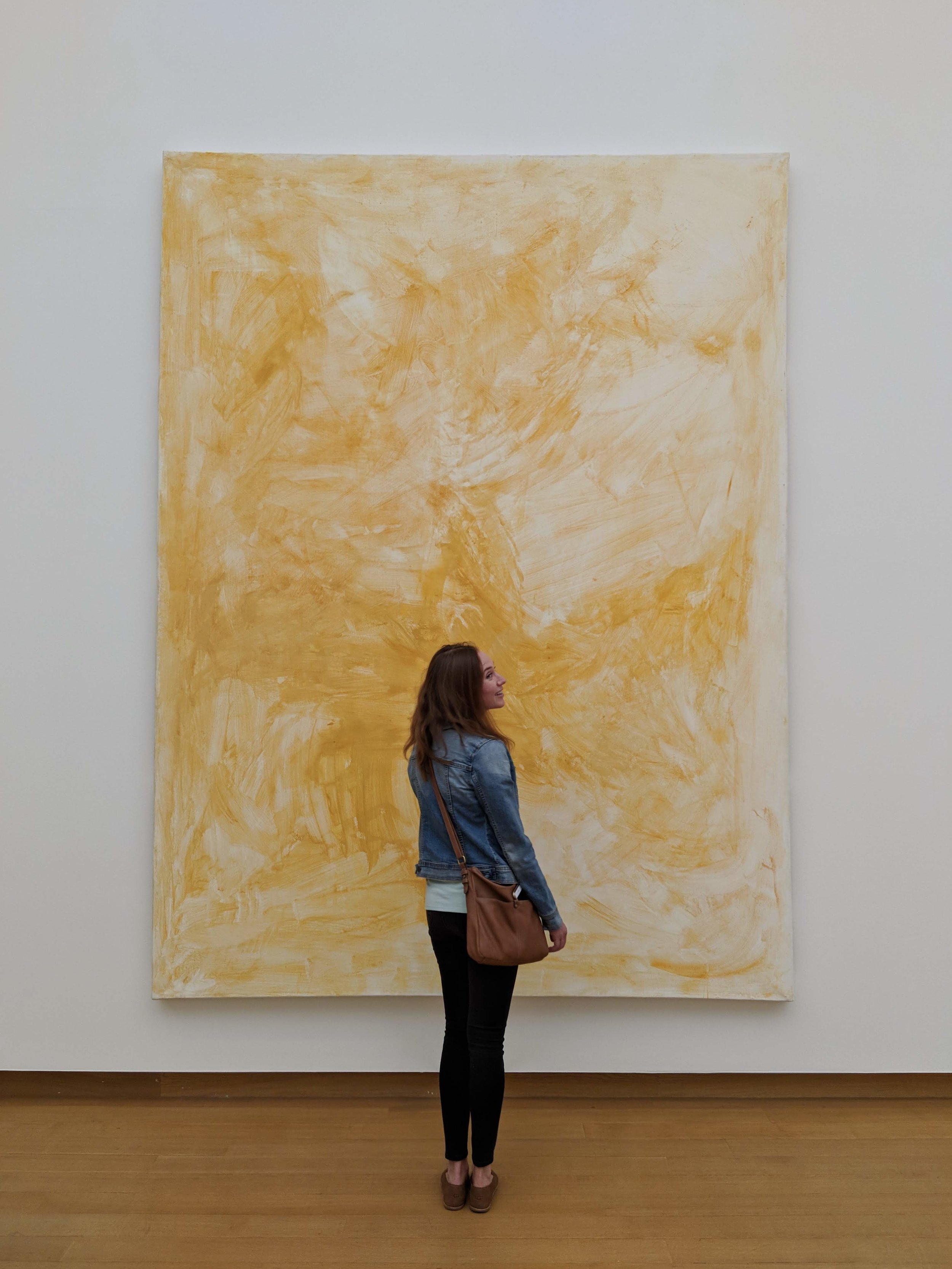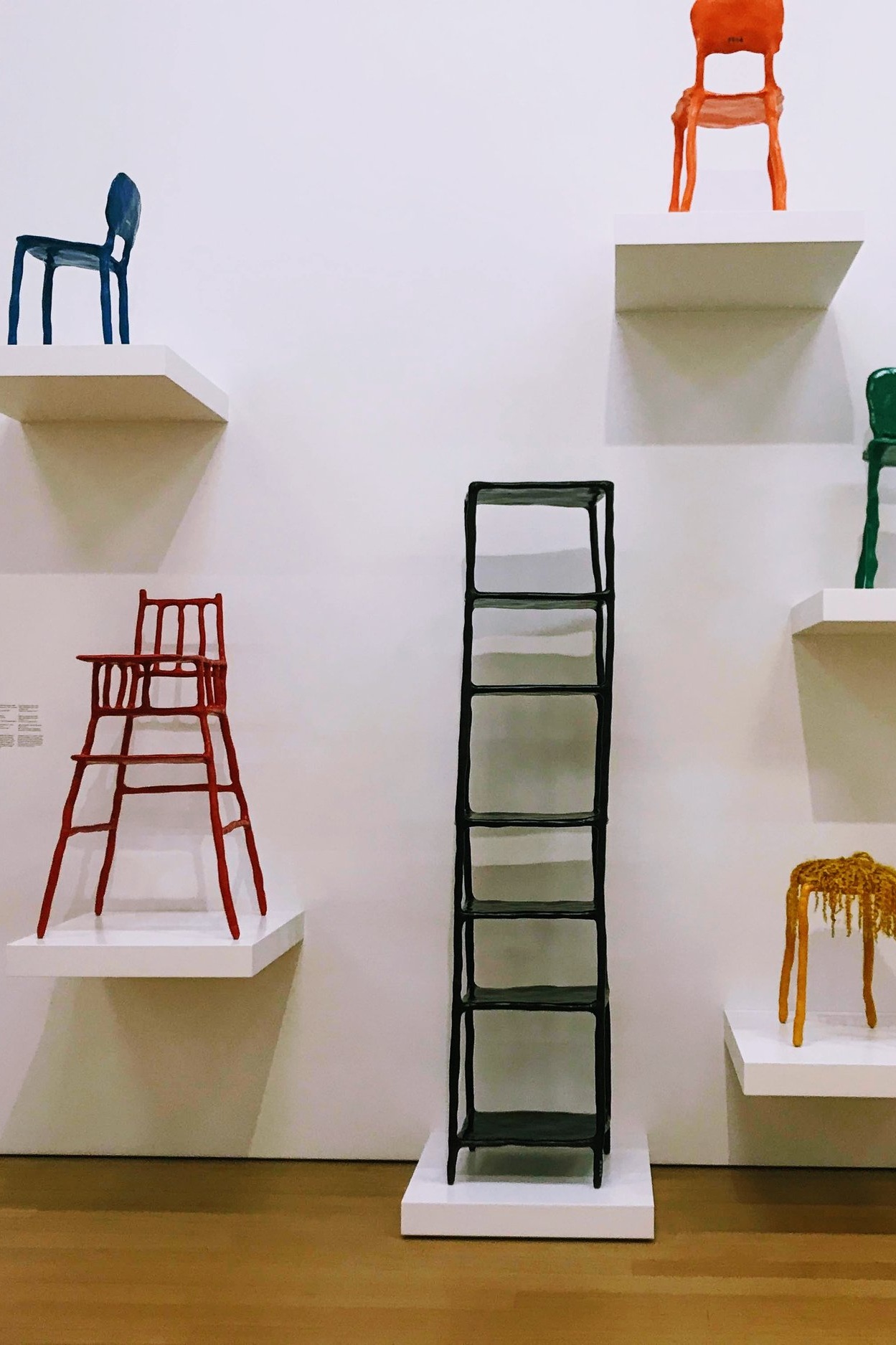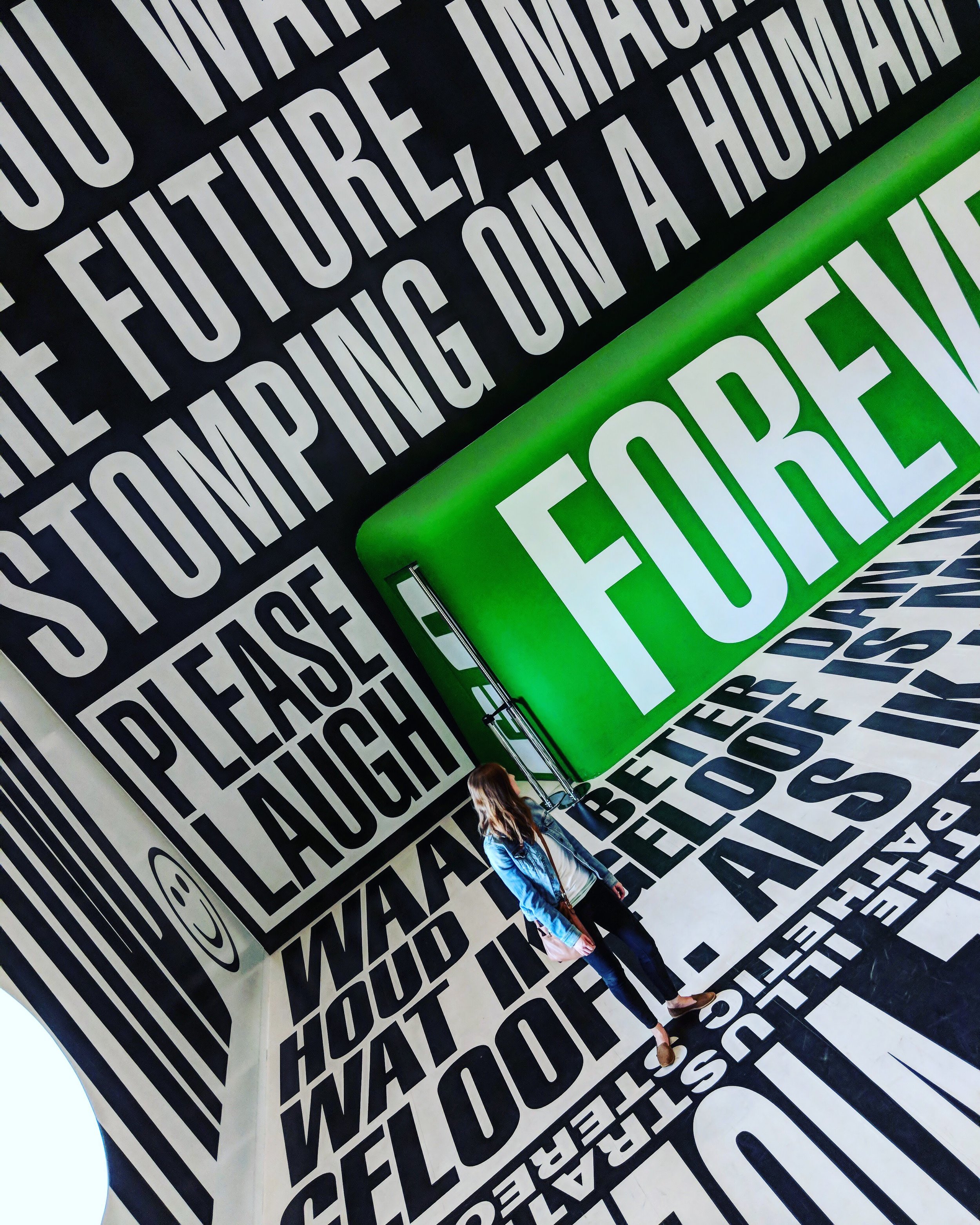Going Dutch: Amsterdam, Netherlands
On my first trip to Amsterdam, I was 20 years old, on mid-semester break while studying abroad in Italy. Six of us all crammed into a friend of a friends dorm room in Utrecht and my strongest memories are from the Heineken Experience. In particular, how we collected extra drink tokens from all the “older” people on the brewery tour (aka 32-year olds like myself now) and took “artsy” photos of the green bottles lining the walls. I know you are dying to see said artsy photo, so here are a few throwback pictures, compliments of Facebook circa 2006. I labeled the beer photo simply: “Deliciousness.” Oh dear, Alex.
A slightly blurrier memory from that same trip involves us not heeding the warning on the wrapper of the space cake eagerly bought at a coffeeshop (remember, coffeeshop = weed, cafe = coffee): “A little goes a long way.”
Which led to sitting in Vondelpark in the sun for hours, eating peanut-butter and jelly sandwiches we made in the dorm kitchen, and the six of us laughing so hard that no sound came out, which made me think for a moment that all the sound in the city had gotten turned off and we were in a silent film, which in turn made us noiselessly laugh harder.
Then, we went to the Van Gogh museum, and my friend was so high she was convinced the guards thought she was trying to smuggle out a painting in her purse, and got so paranoid we had to leave after 15 minutes. Ah, to be young.
But one of the greatest opportunities now that we live in Europe is to revisit those places I first traveled to over a decade ago.
I love everything about that trip and experience. But one of the greatest opportunities now that we live in Europe is to revisit those places I first traveled to over a decade ago, and feel that tinge of nostalgia while seeing each city with new eyes.
During our recent trip last September, we swapped Heineken for craft beer, skipped the Red Light District and coffeeshops, and didn’t just go to one, but four(!), museums. Fair warning: this post is a long one, but I’ve compensated with lots of pictures! This Venice of the North is just so gosh-dern photogenic. Read on for Amsterdam, revisited.
Crooked little houses, all in a row
I didn’t notice this right away, not until my friend Liz, who lives in Amsterdam with her husband and little dog Wally, pointed it out to me. And once you see it, you can’t unsee it - the famous canal houses that line the waterways are crooked. They are so crooked. Leaning this way and that, slanting sides creating triangular gaps between buildings, some even drunkenly tipping forward and lurching over the canals. Slightly disheveled, but oh-so-charmingly so.
Combined with the geometrically intricate gabled roofs and the brick shades of burnt red and rich brown and slate gray, the canal houses feel vibrant and uniquely Dutch. And surprising, these crooked homes are all completely safe to live in. These aging houses, so tightly packed together, support one another, just like old friends should.
In fact, most were intentionally built this way. There are a number of reasons why some canal houses tilt forward, but my favorite is that merchants used to hoist goods up from the street or waterway using a hook and pulley attached near the top of the roof. A leaning facade meant it was less likely for whatever they were lifting to break a window or swing into the wall. Kind of genius, when you think about it.
Apparently, some residents still use them to this day to move furniture in and out of narrow apartments, utilizing their large windows instead of trying to navigate bulky items around the slim stairwells. I would have loved to have seen an overstuffed couch or a flat screen TV dangling in front of an 17th century canal house. Maybe next trip.
And speaking of canal houses, we also did a canal boat tour. It sounds as cheesy and cliche writing it now as it did when it was suggested to us by (multiple) people, but here we are, about do to the same to you. Take a boat tour!
It’s a lovely way to spend an hour, cruising up and down the channels, particularly if the weather is nice, and gives a different perspective of the city. I’m not sure if all boat tours do this or if ours went rogue, but at one point we left the canals completely and went through the open water of the harbor, which was also unexpectedly cool.
The Jordaan vs. De Pijp
Our Saturday was dedicated to neighborhood explorations, and we had our sights set on two main ones: the Jordaan and De Pijp. The historic Jordaan neighborhood is one of the best-loved neighborhoods in Amsterdam, and rightfully so. There are flower boxes, there are bicycles, there are boats gliding down the canals. Jordaan is quiet and sleepy until noon, and then it bangs and bustles into action.
It’s atmospheric, a little bohemian, a lot hipster, and you can easily spend all day wandering over the little bridges, popping into weekend markets, and stumbling into pubs that have 52 different Dutch beers on tap (I’m looking at you, Proeflokaal Arendsnest, with your copper pipes and wood-paneled walls and fantastic selection). But consider yourself warned: these charming Jordaan streets have narrow sidewalks, and bikers rule the roads. The innocent “ding ding ding” of the bicycle bell may sound cute and disarming, but the underlying message is anything but - get out of the way!
There are flower boxes, there are bicycles, there are boats gliding down the canals.
The Saturday Noorderkerk organic market, smack in the middle of the Jordaan, was in full swing the morning we arrived. Deliciously local and very generous with the free samples (and I am a sucker for free samples), this may be one of my favorite farmers markets to date.
We bought fresh bread from a stall where the loaves were baked on site, artichoke hummus spread, and a large hunk of - and I say this quite literally - life-changing pesto-infused Gouda. I’d forgotten that the Dutch are also famous for cheese, and we bought far too much to possibly eat during our short weekend trip, but it was impossible to resist. They know what they are doing with those samples.
Somehow, I resisted the call of the freshly-fried french fries that everyone seemed to have, liberally doused in mayo in a paper cone, and later found out that they are the most popular in the city. Always go with your gut instinct, Alex. Always buy the fries.
The food market connects with a flea market, and all of a sudden you go from tasting sticky sweet blood-orange slices to rummaging through vintage postcards and cassette tapes and faux fur stoles. Raunaq and I took our food finds to the other side of the canal, where we picnick’d in the sunshine while a nearby accordion player serenaded everyone with his rendition of Sia’s “Cheap Thrills.”
A side note on street markets: Amsterdam loves them and there are plenty to go around. If you miss the Noodermarkt, there’s always the Albert Cuypmarkt, ZuiderMRKT, Dappermarkt - the list goes on. And if you are like me and books feed you as much as food does, there’s the Boekenmarkt, too.
De Pijp is also a popular neighborhood, but stands in somewhat stark contrast to the picturesque Jordaan. Think less canal houses, more street art. If I had to choose - and why would you because these neighborhoods are within walking distance and they are both delightful - I would choose De Pijp over Jordaan, but it wins only by a smidge. It just felt a little more casual, a little less crowded, with just as many independent shops and eclectic restaurants. I only wish we had more time to explore it.
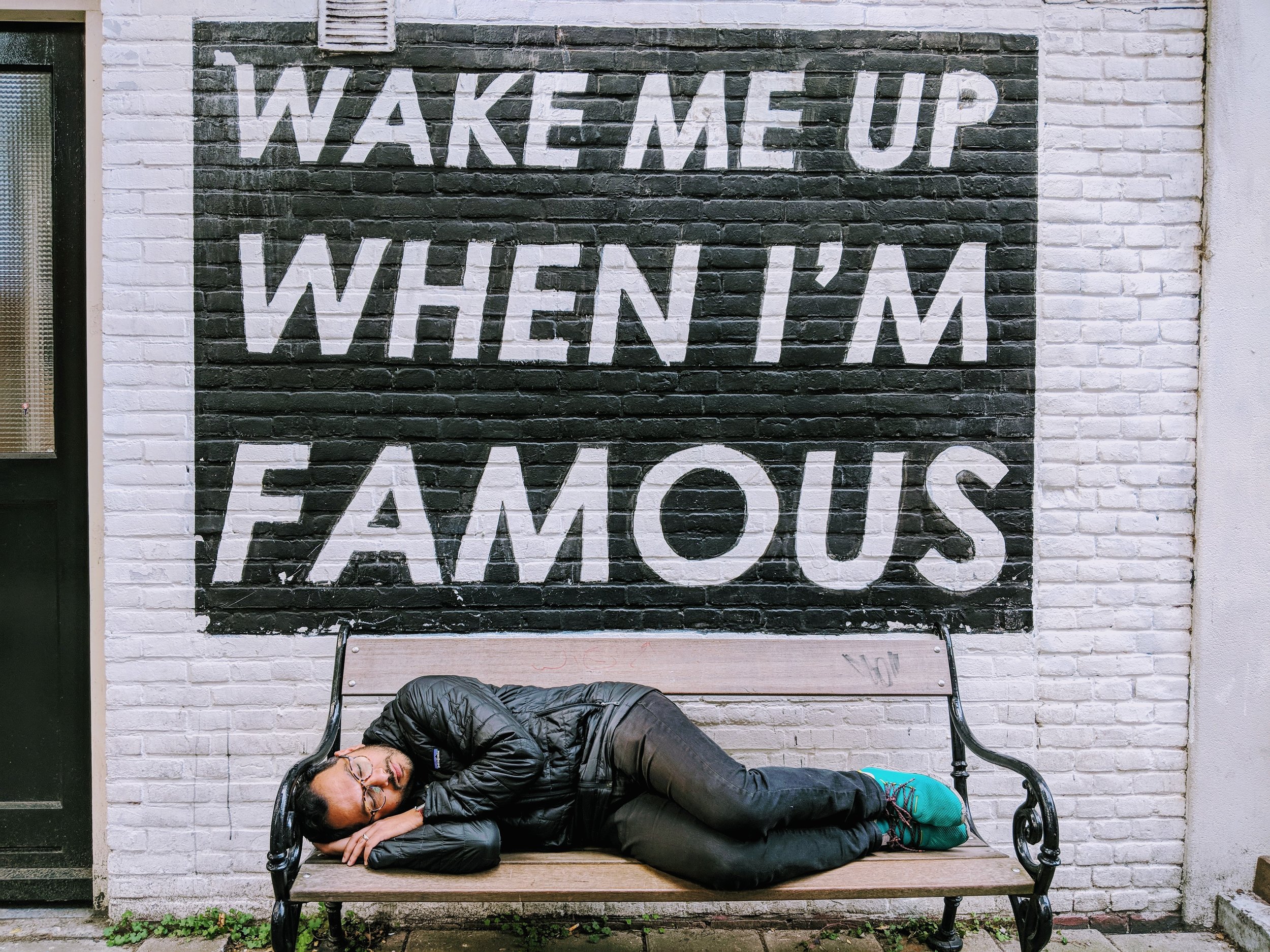
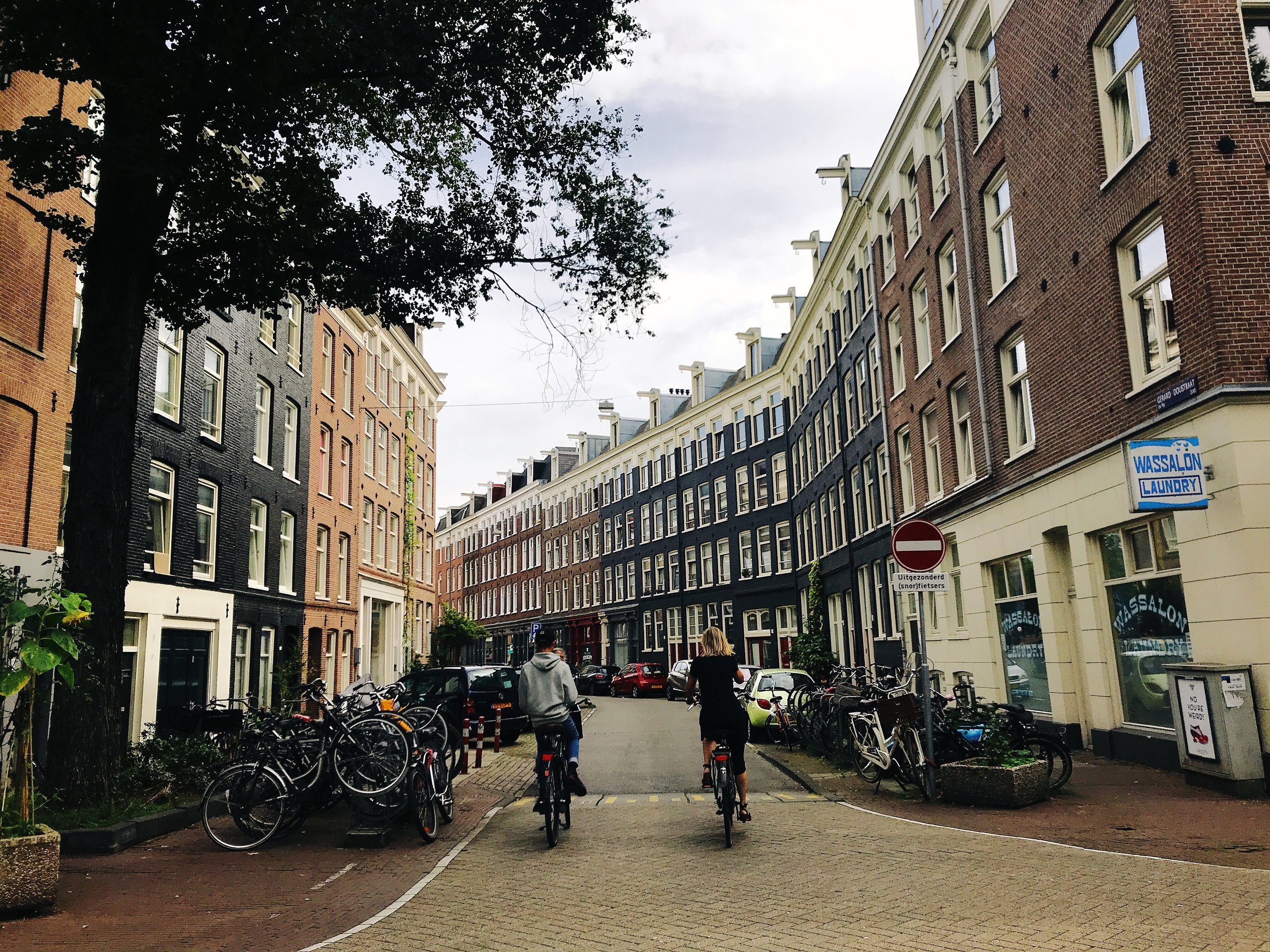
Some guides have compared De Pijp to the Latin Quarter in Paris. While that may have been true at some point, large swaths of Paris’s quarter have unfortunately been overrun with gimmicky tourist shops and tours (at least that was my impression on a recent visit), while De Pijp has seemed to retain its local authenticity and beatnik vibe. Let’s hope it says that way.
Eating and drinking
There may not have been stroopwaffles or thick Dutch fries (big mistake. Huge!) on our weekend menu, but we did eat and drink like kings nonetheless. At least it felt like we did, because everything seemed so cheap and options so diverse, relative to Zurich.
First up was De Winkel, caddy-corner to the Nooderkerk market, for Dutch apple pie with a crumbly crust and homemade cream, and then Bar Fisk in De Pijp for mussels and polenta fries and a cured tuna sandwich. We got dinner at a small tapas spot near our AirBnB in Houthavens called El Hermano de Kique. I don’t remember what we ordered at all, but I know that Raunaq drank a beer con agua del mar. Yep, you translated that right. Seawater.
For drinking, our main focus was a brewery next to a windmill, which felt about as Dutch as you could get. Lots of tall blondes, and I’m not just talking beer varieties, but the clientele, too. Brouwerij 't IJ may be unpronounceable, but it has incredible selection of Amsterdam craft beer, and Raunaq and I were spoilt for choice. Since moving to Switzerland, I had managed to survive four months without anything close to resembling an IPA. And while I am learning to enjoy the lighter Swiss German lagers, sometimes a girl just needs her double hops.
How many museums is too many museums?
We went a bit crazy and tried to fit in four museums in two days: Van Gogh, Rijksmuseum, Stedelijk Museum, and the Anne Frank Haus. It was…aggressive. Culture overload! Not necessarily a bad thing, but I think I wandered into one gallery too many. For a weekend trip, my Goldilocks “just right” amount is two. Two days and two museums seems reasonable, right?
**If you are planning a visit, definitely book any and all museum tickets in advance, otherwise your entire trip will be spent waiting in lines**
The Van Gogh Museum, I think, is a must-visit. Yes, it’s crowded, and maybe you can’t linger over the Sunflowers as long as you’d like, but it’s incredibly curated and fascinating to see, if only to appreciate the sheer volume of work the man produced. Especially once you realize he painted over 900 pieces in less than 10 years, and the bulk of those in the last year of his life while in an asylum. That’s remarkable.
And, I love going to museums that focus on a singular artist. You can see their entire body of work, how their style and ideas changed over the years, who influenced them, and how their personal and artistic lives intertwined. If I saw The Potato Eaters before this visit, I would have never pegged Van Gogh as the artist - the dark, pastoral scene was nearly the opposite of the vivacity and intensity that is synonymous with his later work.
We were lucky enough to catch the Museum Market, filled with local designers, artisans and food stalls, which only happens on the third Sunday of each month. It’s perfect for when you decide to visit both Van Gogh and Rijks on the same day, since the market is in between the two museums and a perfect place for a brain break. We bought our very first piece of original art from a young artist from Rotterdam!
Rembrandt might not be my style, but you have to appreciate the uncompromising and intricate human detail in his portrait paintings.
The Rijksmuseum houses work from all of the Dutch greats, Ruisdael, Vermeer, Rembrandt, and many more, from the Middle Ages to present. Generally, this is not my favorite type of art - but even the building itself is monumentally beautiful, and it’s so big you actually have space to spread out and linger (I actually got lost trying to find the bathroom!). Rembrandt might not be my style, but you have to appreciate the uncompromising and intricate human detail in his portrait paintings. And there is an entire gallery dedicated to showcasing “The Night Watch.”
The curators at Van Gogh and Rijks must have all been out of town when Stedelijk Museum was designed (or maybe they made the same mistake as 20-year Alex and ate too many special brownies), because it’s terribly laid out. Which is a bit ironic for a museum celebrating contemporary design. It kind of looks like all this amazing modern art was just thrown into a basement as an afterthought. But if you can put up with that, you can stumble across Koons and Picasso and Pollack and Rothko, along with newer artists and Insta-worthy exhibits.
It’s unfortunate to say this, but the experience at the Anne Frank Haus was the most disappointing. One million people visit each year, and when I went 12 years ago, I remember it being a sobering, reverent and reflective experience. Standing in the living room of the Annex, feeling like the walls were closing in on me and being overwhelmed with emotion.
But this time, there were simply so many people. Hundreds and hundreds of tourists in a single file line, pushing up against you in each room and impatiently huffing if you take more than a minute to read a placard. There is just no moment to stop and reflect on where you are, the people who lived here, and the millions of others stories they represent. It was hard to experience that this time around, which is truly regrettable.
Should you still visit? Yes. It’s an important landmark and piece of history that should not be forgotten. And I hope you when go, you have the space to take it all in.
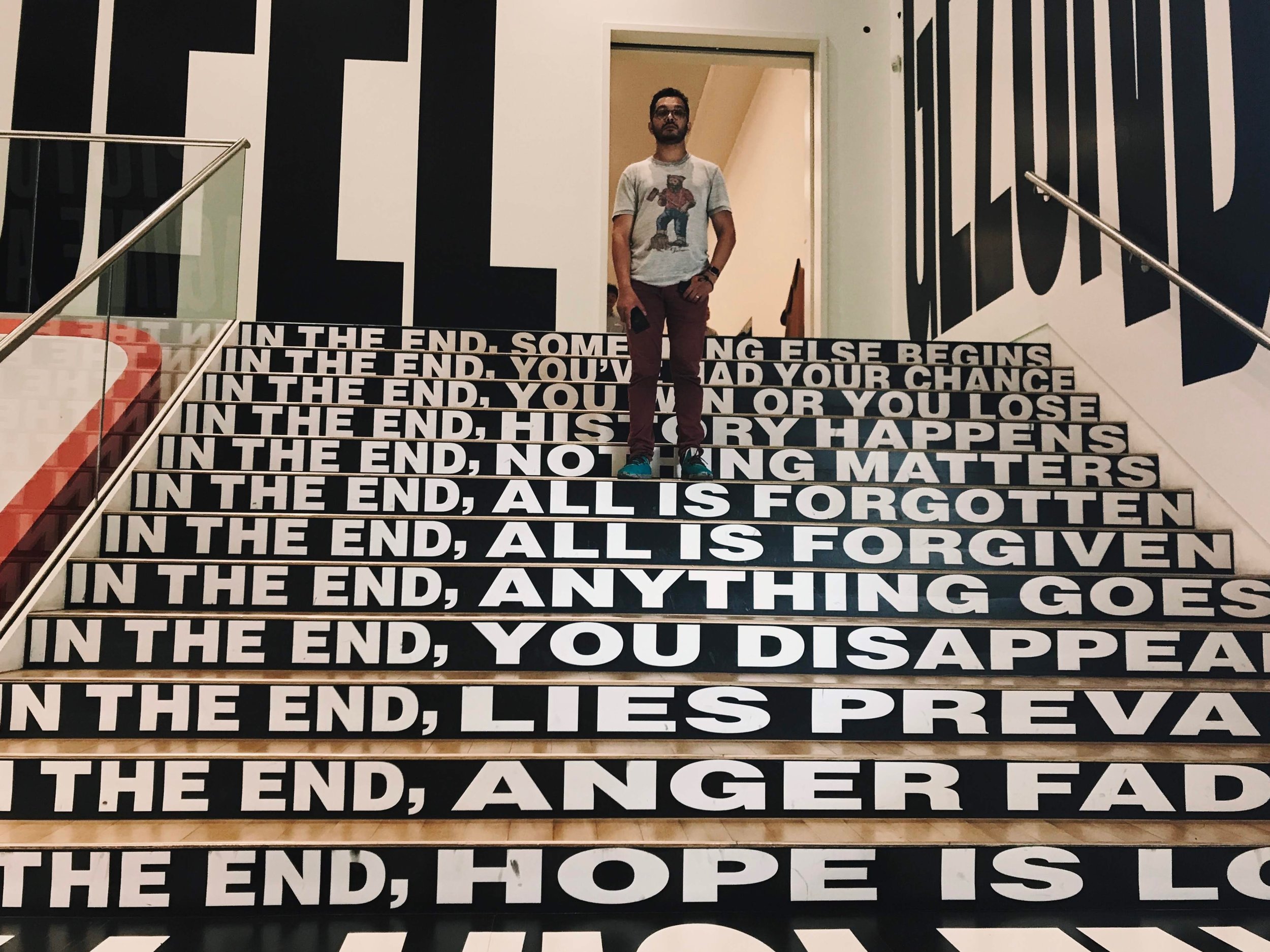

Great food, delicious beer, famous art, huge parks, and a merging of history and contemporary - what is not to love about Amsterdam? Try to avoid the city center, and with it the hordes of tourists/bachelor parties, and you’ve got an incredible weekend.
This post got long without me even realizing it. I didn’t even get to touch on Vondelpark, or Foodhallen, or just sitting on the roof of a friend’s canal house, discussing light topics like immigration and European colonization. It may have been a completely different trip this time around, but whether I’m 20 or 32, Amsterdam is a delightfully fun city to visit.




